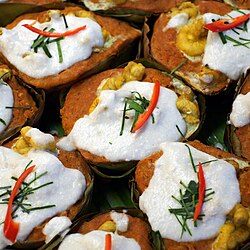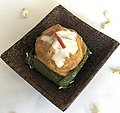 Thai steamed fish curries (ho mok pla) in Chiang Mai, Thailand | |
| Type | Curry |
|---|---|
| Place of origin | Cambodia[1][2][3] or Thailand[4] |
| Region or state | Southeast Asia |
| Associated cuisine | Cambodian, Lao and Thai |
| Main ingredients | Curry paste, coconut cream/coconut milk, eggs |
| Variations | Fish amok |
Steamed curry (Khmer: អាម៉ុក, amŏk lit. 'to steam in banana leaves',[5] [ʔaːmok] or ហហ្មុក,[6] hormŏk; Lao: ໝົກ, mok [mók]; Thai: ห่อหมก lit. 'bury wrap',[4] ho mok [hɔ̀ː.mòk],) is a Southeast Asian type of curry steam-cooked in banana leaves and served with cooked rice.[7] In Laos, it is also roasted on embers.[8] The base of the curry is made with a curry paste (Khmer: គ្រឿង, krœăng [krɨəŋ]; Thai: พริกแกง, prik kaeng) with or without the addition of coconut cream or coconut milk and eggs. A wide range of leaves and staple ingredients are also added to the dish, such as:
- fish (Khmer: អាម៉ុកត្រី, amŏk trei [ʔaːmok trəj]; Lao: ໝົກປາ, mok pa [mók paː]; Thai: ห่อหมกปลา, ho mok pla [hɔ̀ː.mòk plāː]);
- bamboo shoots[9] (Lao: ໝົກໜ່ຳໄມ້, mok nor mai [mók nɔ̄ː mâj] (often with minced meat inside); Thai: ห่อหมกหน่อไม้, ho mok no mai [hɔ̀ː.mòk nɔ̀ː máːj]);
- chicken (Khmer: អាម៉ុកសាច់មាន់, amŏk săch moăn [ʔaːmok sac mŏən]; Thai: ห่อหมกไก่, ho mok kai [hɔ̀ː.mòk kàj]);
- snails[10] (Khmer: អាម៉ុកខ្យង, amŏk khyâng [ʔaːmok kʰjɑːŋ]);
- tofu (Khmer: អាម៉ុកតៅហ៊ូ, amŏk tauhu [ʔaːmok tawhuː]; Thai: ห่อหมกเต้าหู้, [hɔ̀ː.mòk tâw.hûː]);
- algae (Lao: ໝົກໄຄ, [mók kʰáj] (with Mekong weed)).
According to cultural anthropologist Penny Van Esterik, the Southeast Asian coconut-based curries are the result of Indianization, that in the 15th century after the Fall of Angkor, were introduced in the Ayutthaya Kingdom by Khmer royal cooks and later reintroduced back into Cambodia as the Siamese armies attacked into Cambodia. Nowadays, they are considered characteristic of individual Southeast Asian cuisines.[11]
-
Cambodian steamed fish curry (fish amok)
-
Laotian steamed fish curry (mok pa)
-
Thai steamed seafood curry (ho mok thale) served in a coconut


